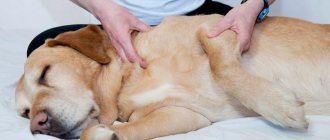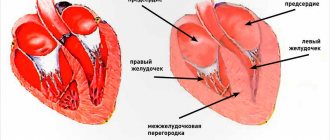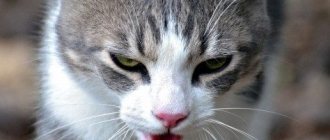Pulmonary edema is the accumulation of fluid in the lung tissue, or, in other words, “water in the lungs.” How is this possible?
The lung consists of small thin-walled sacs - alveoli, entangled in a network of capillaries with blood. Gas exchange constantly occurs between these capillaries and the air in the alveoli - the blood takes oxygen and gives off carbon dioxide, which is then exhaled outside. But when the alveoli, instead of gas, are filled with liquid leaking from the blood vessels, then pulmonary edema occurs. Increased fluid in the lung reduces its volume and elasticity. The result is a violation of gas exchange, oxygen starvation (hypoxia) of all body systems.
Here's what it roughly looks like:
Complication after sterilization
This procedure is now used on most of the adult cat population. Most often, cats tolerate it calmly and recover from anesthesia normally. But in some cases, pulmonary edema may develop in cats after sterilization. The animal sticks out its tongue and becomes immobilized, its mouth turns blue. This condition is a consequence of the fact that before the operation the doctors did not examine the heart and did not identify any abnormalities in its functioning, which now lead to similar complications. In this case, oxygen therapy should be applied to the cat, as well as Furosemide and Prednisolone should be administered intramuscularly or intravenously. Usually the condition improves somewhat after injections, but continued treatment is required.
Signs of edema development
Symptoms of pulmonary edema in a cat may not be clearly expressed in the initial stages, and therefore require great attention from the owners. If the cat suffers from heart disease or is simply an old and weak animal, you need to react as quickly as possible, otherwise you may lose it.
For the most part, the signs of pulmonary edema are obvious, very noticeable and threatening. These include the following symptoms of trouble:
- the animal is choking, breathing with great effort, trying to breathe, but cannot;
- breathing is hoarse, rapid, intermittent, with sounds and whistling;
- the cat may cough, sometimes with sputum and saliva, and foamy discharge;
- the pulse quickens, the animal may meow hoarsely in pain;
- at the beginning of the attack, the cat keeps his head bowed and his front legs spread apart in order to be able to take a deep breath of air, but he is unable to do so;
- if a cat recovers from anesthesia, it may have a confused consciousness, a state of panic, it does not know where it is, it tries to escape, or it simply lies motionless, suffocating;
- cyanosis develops from suffocation, that is, blue discoloration of the mucous membranes caused by oxygen starvation;
- limbs become cold due to the fact that the heart cannot cope with the load, and the blood contains little oxygen;
- pulse weakens;
- The animal’s tongue falls out of its mouth, and the animal itself breathes with an open mouth, which is completely unusual for cats.
INTERESTING TO KNOW: What is the danger of glaucoma in cats
If you even suspect such a condition, it’s time to call the veterinarian, find out his opinion and, at the first command, take your pet to the clinic.
Symptoms
The presence of fluid in a cat's lungs can be suspected by certain manifestations. The main symptoms of this pathological condition are
:
- decreased reactions to external stimuli;
- pallor of mucous membranes;
- heavy, complicated breathing, in which gurgling sounds are clearly audible;
- intense cough with pink sputum;
- sticking out tongue when coughing;
- increased pulse, which gradually becomes weak;
- coldness of paws;
- unsteadiness of gait.
As soon as symptoms of fluid in a cat's lungs are noticed, it should be taken to a veterinarian immediately.
Forecasts
Pulmonary edema in a cat is considered a very serious disease. Veterinarians have special methods of treatment and assistance, but owners should be aware that in some cases this disease is a dying condition. If the animal is young, with a strong immune system, then recovery is possible. However, in this case, the risk of relapse remains. If repeated swelling is observed within several months, this leads to death in almost 100% of cases.
Causes of pathology
There are many reasons why swelling occurs. They are divided into cardiogenic (heart-related) and non-cardiogenic.
Cardiogenic
Due to diseases of the cardiovascular system in the lungs, blood flow in the capillaries is disrupted. As blood flow slows, fluid from the blood vessels enters the cat's lungs.
Cardiogenic pulmonary edema in a cat occurs when:
- Hypertrophic cardiomyopathy.
- Chronic heart valve diseases.
- Heart defect.
- Heart failure.
- Arterial hypertension.
- Cardiosclerosis.
- Pulmonary embolism.
Most often, these causes of pulmonary edema occur in cats of artificially bred breeds.
Non-cardiogenic
This type includes all other conditions that are not related to the work of the heart.
- Allergic reactions (including to anesthesia).
- Aspiration pneumonia.
- Injuries to internal organs as a result of falls from height.
- Electric shock.
- Reaction to medications.
- Choking (carbon smoke poisoning).
- Anemia.
- Heatstroke.
- Lung cancer.
- Laryngeal paralysis.
- Head injuries: bruise and concussion.
- Severe stress.
- Injuries to internal organs during sterilization/castration operations.
- Poisoning with poisons and chemicals.
- Bacterial blood infections.
- Pancreatitis.
- Prolonged seizures (epilepsy).
- Poisonous snake bites.
- Uremia is intoxication resulting from renal failure.
- Anorexia.
- Sepsis.
- Aspiration is the entry of vomit into the respiratory tract.
It is necessary to show the animal to a veterinarian in all of the above cases.
Pulmonary edema after spay/neuter surgery
Many cat owners refuse cat sterilization surgery for fear of developing postoperative pulmonary edema. Such cases have been recorded in veterinary medicine. Pathology develops as a cat's reaction to anesthesia.
Fluid in a cat's lungs after anesthesia accumulates not because of the operation itself. But because the animal had chronic heart problems. Therefore, it is important to carry out all the necessary studies before surgery to make sure that the pet does not have heart problems.
Causes
Often pulmonary edema is of cardiac origin. When a cat has a disturbance in the pulmonary circulation, blood stagnation develops in the lungs and the alveoli fill with fluid. Cardiac pathologies that can lead to swelling of the lung tissue include
:
- heart disease;
- thromboembolism of the pulmonary artery;
- aortic heart disease;
- cardiomyopathy.
In all these cases, the fluid first appears in the lower sections and gradually rises up to the bronchi.
Fluid accumulation in the lungs not due to heart problems can occur due to the following:
:
- the cat inhaling very hot air;
- long-term exposure to chemical gases on the animal’s respiratory system;
- lobar pneumonia;
- sunstroke;
- heatstroke;
- feline distemper;
- electrical injuries;
- traumatic brain injuries;
- sepsis;
- serious drug overdoses;
- renal failure;
- acute allergic reactions;
- cancerous tumors;
- asthma.
If there are factors predisposing to the onset of the disease, monitoring the cat’s condition should be especially careful. If there is the slightest suspicion of the onset of the development of a pathological condition, the animal must be immediately shown to a veterinarian.
Types of pulmonary edema
Thus, taking into account the mechanism by which the pathology develops, cardiogenic, non-cardiogenic and mixed pulmonary edema are distinguished.
Cardiogenic (so-called cardiac) pulmonary edema develops due to an increase in hydrostatic pressure in the pulmonary circulation system, leading to the occurrence of acute left ventricular failure. In this case, any reason leading to an increase in pressure in the pulmonary artery is important. Rapidly increasing hydrostatic pressure in the pulmonary circulation leads to pathological effusion of fluid into the lung tissue, and then into the alveoli. Most often, cardiogenic pulmonary edema develops against the background of arterial hypertension, cardiosclerosis, and various heart defects.
Noncardiogenic pulmonary edema is the accumulation of fluid in the interstitial tissue of the lung and alveoli, not associated with heart disease. It occurs due to increased capillary permeability rather than as a result of increased hydrostatic pressure, unlike cardiogenic pulmonary edema. It occurs mainly in dogs, less often in cats. The most common causes include upper airway obstruction (larynx paralysis, foreign bodies, abscesses), traumatic brain injury, smoke inhalation, sepsis, and anaphylactic shock in cats.
Pulmonary edema symptoms
Pulmonary edema in animals is a critical condition requiring emergency care. The disease is accompanied by the following symptoms:
- dyspnea,
- rapid breathing,
- restless behavior
- cyanosis (blueness) of the mucous membranes of the oral cavity,
- copious discharge of foamy pink sputum, which can be mistaken for vomit or saliva,
- tachycardia,
- open mouth breathing in cats.
Symptoms may appear suddenly, depending on the cause of the swelling, and lead to severe respiratory failure, which is life-threatening.
How does the disease manifest itself?
How can you detect pulmonary edema in cats? The symptoms can be quite different, however, we will list them all so that the owners know what to look for.
First of all, your pet should be alert to rapid breathing and shortness of breath. Even a slight manifestation of these signs is a sufficient reason to contact a veterinarian.
We have already looked at how pulmonary edema develops in cats. The reasons in each case may be different, which means the intensity of the development of symptoms will also differ. The owner should be wary of abdominal breathing, since this is an atypical method for representatives of this species, and it indicates obvious problems.
In later stages, your pet will suffer more and more. His mucous membranes turn blue, the cat breathes with an open mouth and clearly visible wheezing. Even later, a cough with sputum and blood appears, the limbs become cold - it is almost impossible to save the animal at this stage.
Pulmonary edema in cats: symptoms
The following signs are noted:
- the pet breathes heavily with an open mouth;
- the paws are spaced wide apart, the head is tilted, in some cases the cat lies on its side and makes fruitless attempts to rise;
- the eyes are indifferent, the pupils are dilated, the animal is scared;
- the pet does not respond to the owner’s call or the surrounding environment;
- the mucous membranes first acquire a pale tint, then become bluish;
- the cat coughs excessively, the alveoli are injured, pink-colored sputum comes out;
- Foamy discharge begins to fall out of the nose and mouth;
- the tongue falls out of the mouth;
- The heartbeat is initially rapid, but subsequently becomes intermittent and weakens.
The heart tries to provide oxygen to the vessels of the brain; it does not have enough strength to reach the periphery. Therefore, the paws become icy.
There are the following cat breeds that are prone to heart failure, and therefore edema:
- Maine Coons;
- British;
- Sphinxes;
- Scots;
- Persians.
Kittens do not have cardiogenic pulmonary edema. They suffer due to chest injuries.
Causes of pulmonary edema in cats
An attack of cardiac asthma can be triggered by the following factors:
- radiation sickness;
- bronchial asthma;
- drug overdose;
- hernia;
- neoplasms, lung tumors can cause compression;
- airway obstruction;
- exposure to toxins;
- traumatic injuries;
- swelling due to kidney disease;
- feline leukemia;
- congestive heart failure;
- pneumonia;
- feline infectious peritonitis;
- blood clot formation;
- parasitic infection;
- chylothorax;
- viral infection;
- anemia;
- overdose of anesthesia during castration/sterilization.
Abnormal accumulation of fluid in the alveoli
For your information! Most often, heart disease provokes the formation of edema. A characteristic sign is that only the hind limbs can swell.
Non-cardiogenic form
In this case, the doctor needs to understand the reasons that led to such a violation. This may be a consequence of electrical trauma and brain damage. If such an event occurred, then you must definitely go to the clinic. Such swelling may not develop immediately - this is the main danger.
An infectious pathology can also lead to a similar result. In this case, inflammatory edema develops. The cause of this complication may be a disruption of the gastrointestinal tract. Another broad category is toxic swelling, which is caused by carbon monoxide poisoning or snake venom.
Allergic conditions and anaphylactic shock, septic shock, tumors blocking the lymphatic vessels - all these are also options for events in the presence of which pulmonary edema develops.
First aid
If you observe one or more of the symptoms described in your pet, then remember that the sooner you take him to the hospital, the better the doctor’s chance of treating pulmonary edema in cats. Treatment is symptomatic, and depending on the severity of the symptoms, the specialist may change the treatment regimen. The animal must be placed in a ventilated room and drafts should be avoided.
Before you arrive at the hospital, do not try to give the animal water or force it to rest. In addition, it is very dangerous to independently give an animal drugs to stimulate breathing, try to pump out fluid, or perform artificial respiration. Many owners ask doctors whether pulmonary edema in cats is fatal or not? In some cases, this disease can be fatal, however, competent therapy can save if this complication is at an early stage. Edema requires intensive care and constant medical supervision, so in this case, hospital treatment is the best option.
What is pulmonary edema in cats
Edema occurs due to excess fluid accumulation in the tissues. This is not an independent pathology, but a symptom of the underlying disease.
If fluid is allowed to fill the entire lung tissue, the cat will die from respiratory arrest. When half of the lungs do not function, oxygen starvation of the organs develops, primarily the brain.
What is pulmonary edema
The lungs consist of two paired organs and inside have a large number of alveoli (cells). The process of breathing in animals, as in humans, occurs with the participation of alveoli - peculiar bubble formations in the lungs, intertwined with a network of blood vessels. Under normal conditions, the alveoli of the lungs during inhalation are filled with oxygen entering the blood, which then carries it to the brain, nourishes the heart and tissues. When you exhale, exhaust air containing carbon dioxide is released through the alveoli.
In pulmonary insufficiency (edema), for various reasons, transudate (edematous fluid) and the liquid part of the blood enter the alveoli - infiltration. A sharp decrease in the working volume of the lungs disrupts the breathing process and leads to progressive oxygen starvation of the body.
Diagnostics
If the doctor makes a diagnosis only on the basis of an initial examination, take your pet and go in search of a more competent specialist. An accurate diagnosis cannot be made without a comprehensive examination. The veterinarian must prescribe an ultrasound, do an x-ray and take tests. Only based on the results can a specialist make a final diagnosis. However, you will not be sent home to wait for the tests to be ready: ultrasound and x-rays can be done almost instantly in most clinics. After this, if suspicions of edema are confirmed, leave the pet in the hospital. The test results will only tell the doctor what direction to work in, or rather, what the root cause of the swelling lies.
Basic treatment
As we have already said, it will be symptomatic, that is, the doctor must, based on the condition of the animal, decide which drug is the priority today. It is very important to give expectorants and cordials. There is a wide choice here, and depending on the situation, the veterinarian can prescribe Cordiamin, Sulfocamphocaine, adrenaline or caffeine. Sometimes it is useful to do bloodletting. A glucose solution (40%) or a calcium chloride solution (10%) is used intravenously. In addition, it is very important to evaluate clinical tests:
- If a cat has symptoms of plague, then additional antiviral drugs are prescribed.
- If a cat has symptoms of hypostatic pneumonia, antibiotics are additionally used.
- Diuretics are essential for optimal treatment. Lasix or Furosemide are often prescribed.
Remember that the decision about the necessary treatment should be made only by the doctor. In the case of self-therapy, the possibility of death increases several times. However, feline pulmonary edema can be treated. The most important thing is not to waste time and be sure to contact the clinic at the first symptoms.
Pulmonary edema in cats: treatment
Treatment begins before a final diagnosis is made. Resuscitation procedures are carried out. The cat is hospitalized and put on an oxygen mask or placed in an oxygen chamber.
To remove excess fluid from the lungs, diuretics are injected. They use drugs that support heart function, stimulate breathing, and stop the inflammatory process.
If it is determined that pulmonary edema is due to a bacterial infection, antibiotics are prescribed. After the acute symptoms are relieved, the diagnosis is clarified. To do this, a general as well as a biochemical blood test and instrumental studies are performed - x-rays, ultrasound, ECG. After deciphering the results, treatment is prescribed.
Prevention
There is no specific prevention, because pulmonary edema itself does not develop in cats. This is a complication, that is, a consequence that is preceded by one of the diseases listed above. It is impossible to foresee everything, especially since our younger brothers cannot explain that they felt bad and where it hurts. However, prevention can be expressed in regular visits to the doctor. Preventive examinations and monitoring of the body’s condition will not allow a situation where you learn about your pet’s heart failure only when pulmonary edema develops.
Disease prevention
There are no special preventive measures to protect against the disease. Prevention consists of careful monitoring of animals that are at risk for cardiovascular and colds. These are predisposed breeds (Maine Coons, Sphynxes, Persians, Scottish, British), weakened, with low immunity, overweight, animals that move little.
If the disease is cured in time, then we can say with a high degree of confidence that complications will not develop.
The main preventive measures are:
- protect the cat from physical overload;
- protect from unfavorable environmental conditions (avoid overheating and hypothermia, being in drafts);
- monitor the safety of cats and kittens at home (protect access to wires and electrical appliances, ensure that the animal cannot inhale fumes of aggressive chemicals, protect from falls and injuries);
- strengthen the immune system, do not skip scheduled vaccinations;
- undergo regular preventive examinations with a veterinarian.
The disease often has a poor prognosis. But the attention and love of the owner can work a miracle. Competent and timely veterinary care (especially in non-cardiogenic disease) makes the chances of recovery quite high.
source
Causes of the condition in cats
But for what reasons does pulmonary edema develop in cats? Is there any way to protect your four-legged friend? How to correctly recognize it and help a purr with such a severe pathology? There are many causes of pulmonary edema in cats. Let's look at all the possible options.
Dehydration
No matter how strange it may sound, pulmonary edema in a cat can develop both due to starvation and due to poisoning. In this case, a huge amount of water leaves through the gastrointestinal tract, and the pet becomes dehydrated.
As a result, the oncotic pressure decreases, and the liquid fraction begins to sweat out of the blood. It is this that accumulates in the lungs, causing swelling. In addition, problems with the kidneys and liver lead to a decrease in oncotic pressure.
Increased permeability of blood vessels (distress syndrome) can aggravate the condition. It develops due to poisoning with serious poisons, medications, smoke and toxic fumes, and due to previous injuries (including pulmonary injuries). Many diseases of internal organs (even pancreatitis) can lead to the vessel wall becoming less durable and capable of allowing fluid to pass through its surface into the intercellular space.
Heart failure can also cause pulmonary edema in a cat. The pet may have problems with the heart itself, or the purr is constantly tired (the heart is almost worn out). Therefore, if you already know about this illness in your pet, keep in mind that he is at risk. And for you, this is another reason to monitor him more carefully.
Other reasons
Tumors and other neoplasms can also be causes, but relatively less often than those mentioned above.
In determining the causes of pulmonary edema, there are provoking factors and direct mechanisms for the occurrence of the disease.
According to the mechanisms of occurrence there are:
- Cardiogenic. Occurs against the background of acute or chronic heart failure. The most common causes are heart defects, arterial hypertension and cardiosclerosis.
- Non-cardiogenic – quite rare in cats. Usually associated with blockage of the upper respiratory tract - swelling or paralysis of the larynx, abscesses, foreign bodies, as well as anaphylactic shock and gas poisoning.
Provoking factors include various chest injuries, concussions and electrical injuries. This also includes the entry of vomit into the respiratory tract.
Another reason for the development of the disease can be inflammatory infectious processes.
Which develop directly in the tissues of the lungs - pneumonia, tuberculosis, carnivore plague.
Neoplasms are also one of the reasons for the development of edema. As well as diseases of other organs and systems - kidneys, liver and poisons.
We suggest you read: Is it possible to sterilize a pregnant cat?
Pulmonary edema in cats occurs due to the overflow of pulmonary capillaries with blood, accompanied by the release of the liquid part into the surrounding tissues. By its nature, the disease can be cardiogenic, that is, arising against the background of heart disease, and non-cardiogenic.
Heart reasons
Cardiogenic edema, as already noted, is the result of heart failure. As a rule, with weak functioning of the left ventricle (one of the parts of the heart), the work of the pulmonary circulation is disrupted, which leads to stagnation of blood in the lungs and subsequent leakage of fluid into the surrounding tissues.
This state can be compared to a porous sponge: up to a certain point, it swells and absorbs water without leaving a trace, but there comes a moment when there is no space left and the water flows out.
For cardiogenic causes, edema begins in the lower sections, but gradually the process moves to the bronchi.
It is worth noting that the prognosis for pulmonary edema is unfavorable, especially if it is caused by a heart defect.
Other factors
Non-cardiogenic causes of hyperemia (another name for the disease) are the following:
- inhalation of hot air;
- inhalation of potent gases with a pungent odor (for example, prolonged exposure to high concentrations of ammonia vapor will easily cause swelling);
- lobar pneumonia;
- heat or sunstroke;
- bacterial or viral infections that affect the lungs (pasteurellosis, canine distemper, etc.);
- exposure to electric current;
- brain injuries due to an unsuccessful fall or blows;
- development of the septic process;
- taking certain potent medications in dosages significantly higher than recommended;
- renal failure, when the protein concentration in the blood sharply decreases;
- allergy;
- bronchial asthma;
- malignant tumors in the lungs that interfere with normal blood supply.
It is important to understand that pulmonary edema is a serious and very severe pathology, often ending in the death of a cat.
Pulmonary edema in a cat is accompanied by coughing and difficulty breathing.
An animal suffering from heart defects, especially if it is already of advanced age, is at risk. Therefore, any self-respecting owner of a sick pet should learn to recognize the signs of impending danger. And they are:
- the cat suddenly takes a forced pose: stands with its forelimbs widely spaced and its head bowed, thereby trying to inhale as much air as possible, its sides are greatly inflated;
- paws become cold;
- after a while the animal falls exhausted on its side and never gets up again;
- the mucous membranes of the mouth turn pale or become cyanotic;
- the animal has difficulty breathing, coughs heavily, and produces pinkish sputum;
- seething, bubbling cough;
- foamy discharge may occur from the nose and mouth;
- tongue hangs out;
- the work of the heart weakens, the pulse first quickens, and then becomes weak and intermittent;
- death occurs as a result of paralysis of the respiratory center.
The behavior of the animal also changes:
- firstly, he is scared, and fear can be read in everything;
- secondly, the lack of oxygen confuses the consciousness, the gaze becomes crazy, and then empty and unseeing;
- thirdly, the cat stops reacting to its surroundings and does not recognize its owners at all.
Despite the fact that edema is an acute and rapidly developing condition, you can notice the approaching danger in advance if you carefully observe your pet and its behavior. Typically, within a few days the breathing rhythm may become disrupted:
- the animal breathes with its stomach (the abdominal stacks shake) or through the mouth;
- the number of rhythmic inhalations and exhalations per minute increases significantly (more than 40);
- the breathing itself is wheezing and labored with periodic hacking coughing.
It is clear that such symptoms do not always indicate developing edema, but the time to ring the bells has already come. It is better to play it safe and take the animal for diagnostics to a clinic, where they will order an x-ray and perform auscultation (in other words, they will listen to the lungs using a special device) and check the functioning of the heart.
Moreover, it is better to film a cough and an altered state on video - fortunately, now almost everyone has a phone with a camera. This will help the veterinarian see the progression of the disease over time, decide on the prescription of additional diagnostic tests and speed up the diagnosis.
Important! It is much easier to cure a process that is caught in a timely manner than to try to correct a neglected and altered condition, which is most often no longer compatible with life.
There is no need to console yourself with excessive hopes: in most cases, pathology is regarded as a dying condition! There is a chance to rescue an animal from the dead only if non-cardiogenic edema occurs.
Even if it was possible to stop the development of the process in the case of cardiac causes, the likelihood of a recurrence of the attack is too high.
If your cat has pulmonary edema, your cat needs immediate medical attention.
The disease requires immediate intervention from specialists; attempts to help the pet on your own will significantly aggravate the condition and hasten the approach of death.
All that the owner can do (provided that the swelling occurs due to heart failure) is to inject a solution of furosemide intramuscularly - a diuretic drug helps remove fluid from the body - and urgently go to the veterinary clinic.
Important! Using diuretics unless prescribed by your veterinarian is still not recommended.
In case of hyperemia, resuscitation cannot be avoided; further observation in a hospital is required. It is not possible to cure an animal with a telephone consultation!
When going to the hospital, it is important to try not to irritate the animal, especially at the time of the attack, so that the situation does not become even more complicated. There is no need to fuss, run, sob, cry - the cat feels all this and, naturally, gets stressed. And stress, as we know, does not lead to good things.
The resuscitation scheme usually includes the use of an oxygen cushion (chamber), in some cases tracheotomy and the administration of:
- diuretics (diuretics) to remove accumulated water in the lungs;
- defoamers;
- vasodilators;
- cardiac drugs to stabilize the heart;
- bloodletting;
- novocaine blockade of sympathetic nodes.
After the crisis has passed, the animal is placed in a cool, well-ventilated room (but ventilation does not mean a draft) and symptomatic treatment is applied: expectorants, antibiotics, etc. It is very important to determine the cause of the edema and eliminate it.
Most cases of pulmonary hyperemia end in the development of complications, which also need to be, if not prevented, then at least correctly diagnosed and treated. The most common consequences include:
- pneumonia;
- collapse of the alveoli (atelectasis);
- overgrowth of the alveoli with connective tissue (pneumosclerosis);
- emphysema - overfilling of the alveoli with air followed by their rupture.
In addition, prolonged oxygen starvation negatively affects almost all organs, especially the cells of the brain and kidneys.
For cats with heart problems, constant monitoring of the state of the cardiovascular system and heart function is necessary. It is especially important to constantly monitor animals at risk:
- obese people;
- with confirmed caryomyopathy;
- leading a “sofa” lifestyle;
- having relatives with heart problems;
- British, Scots, Macoons, Persians, Abyssinians and Sphynxes - those breeds that most often suffer from heart disease;
- drowsy and easily overtired.
Causes
Pulmonary edema in cats develops as a result of various causes. But it is worth remembering that this pathology is not a disease. Pulmonary edema is a serious symptom and type of complication that occurs against the background of an underlying illness.
Pulmonary edema in cats is divided into two main types:
- cardiogenic pulmonary edema in cats;
- swelling not associated with diseases of the cardiovascular system.
Cardiogenic
Very often, the cause of pulmonary edema in cats lies in heart disease. Some destructive processes in the heart and blood vessels lead to a deterioration in the flow of blood and lymph, as a result of which fluids stagnate and begin to fill the lungs.
Lung tissue itself is very porous, and it is full of cells, which is why this organ suffers in the first place. Cardiogenic pulmonary edema in cats is characterized by a gradual filling of the alveoli with fluid, an increase in oxygen starvation of tissues, turning into asphyxia. In this case, in order to save the animal, resuscitation measures cannot be avoided.
Cardiogenic pulmonary edema in a cat occurs when:
- Hypertrophic cardiomyopathy.
- Chronic heart valve diseases.
- Heart defect.
- Heart failure.
- Arterial hypertension.
- Cardiosclerosis.
- Pulmonary embolism.
Heart disease can be congenital or acquired. Cats of artificially bred breeds suffer from similar ailments more often.
Non-cardiogenic
The cause of pulmonary edema can also lie in injuries, disorders in the body, infectious diseases, and others:
- Allergic reactions (including to anesthesia).
- Aspiration pneumonia.
- Injuries to internal organs as a result of falls from height.
- Electric shock.
- Choking (carbon smoke poisoning).
- Anemia.
- Heatstroke.
- Lung cancer.
- Laryngeal paralysis.
- Head injuries: bruise and concussion.
- Severe stress.
- Injuries to internal organs during sterilization/castration operations.
- Poisoning with poisons and chemicals.
- Bacterial blood infections.
- Pancreatitis.
- Prolonged seizures (epilepsy).
- Poisonous snake bites.
- Uremia is intoxication resulting from renal failure.
- Anorexia.
- Sepsis.
- Aspiration is the entry of vomit into the respiratory tract.
Many owners who love to overfeed their pets are unaware that obesity leads to heart disease. This, in turn, entails other problems, including swelling of the organs.











